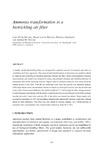Ammonia transformation in a biotrickling air filter

View/
Use this link to cite
http://hdl.handle.net/2183/12818Collections
Metadata
Show full item recordTitle
Ammonia transformation in a biotrickling air filterDate
2007Citation
Biotechniques for Air Pollution Control II, 2007: 263-271. ISBN: 978-84-9749-258-4
Abstract
[Abstract] A simple, tubular biotrickling filter was designed for optimal removal of ammonia and odour in ventilation air from a pig house. The removal and transformation of ammonia was studied in detail by analysis and modelling of chemical gradients through the filter. Good correspondence between measurements and model was obtained by using conventional substrate and inhibition kinetics of ammonium and nitrite oxidizing bacteria. Highest rates of ammonia removal were observed in the central section of the filter. Near the air outlet and water inlet the process was ammonia limited, while high nitrous acid concentrations almost excluded any biological activity near the air inlet and water outlet. Nitrous acid inhibition also stabilized pH at 6.5-7 all through the filter. Being sensitive to both ammonia and nitrous acid the nitrite oxidation process occurred mainly in the filter sections near the air outlet / water inlet, and only 8% of the nitrite was turned into nitrate. Water supply only exceeded evaporation by 20% but modelling indicated that additional watering would have limited effect on filter efficiency. The filter was also robust to varying loading, as a 4-fold increase in ammonia inlet concentration only reduced filter efficiency from 86 to 76%.
ISBN
978-84-9749-258-4





